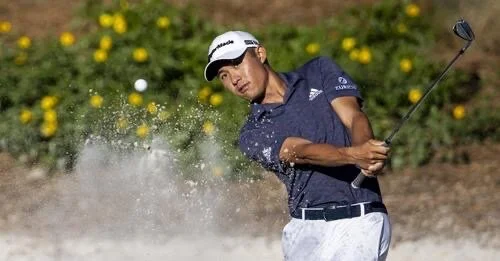Can’t putt like Morikawa? It’s not you. And it’s par for the course.
Note to Coach’s Box readers: This is my weekly column and the photo of Collin Morikawa from the Cincinnati Enquirer and Cincinnati.com.
By Mike Bass
mbass@mikebasscoaching.com
We expect the best of the best golfers in the world, and so we hold the pros to high standards.
This was what I did in the media. It was my job.
This is what you do as fans. It is your right.
Something wacky happens to us when we are the ones playing golf. We all hold ourselves to the same standards. Par is par. It is evident on the scorecard, on the tee sign and in our heads. It warps our expectations.
Take a golfer we will call Trey.
While PGA players were preparing to start the British Open last week, I was performance-coaching Trey. His goal: Stop three-putting so much but stay positive.
Which sounds reasonable.
We explored this concept of “too many” three-putts. This, Trey lamented, is not what the pros do.
Which is true. Just not reasonable.
A PGA player will average a three-putt about once every two rounds, according to PGATour.com. Trey is not a pro. He is an occasional golfer who plays public courses every couple of weeks. Maybe. He sees how those three-putts will affect his score. They also affect him.
This is when I can help. I am not the kind of coach who looks at your swing, stance or grip. I help you look at your approach to golf, to your game and to yourself.
We looked closer at Trey’s expectations. I asked him if he had heard of “personal par.” He had not. It is each golfer’s realistic projection for a particular hole or course.
If, say, a 6 is realistic for a certain 500-yard hole, make that your personal par. If a 120 or 100 is realistic for a certain course, make that your personal par — or subtract a few strokes as incentive to improve.
We looked at Trey and his three-putting. Taken in a vacuum, this can frustrate any golfer. But is this really unconditional? What about the distance of the putts? The slope or speed of the greens? The weather?
What about the You Factor? Are you rested? Healthy? Stressed? Is your mind elsewhere? Are you confident in each putt. Do you know the greens? Do your playing partners trigger your anxiety? Do you worry they will judge you?
Trey volunteered that he would putt better if he played more. This is good awareness and a good start.
We looked at what Trey could reasonably expect today (not potentially), putting from various distances. At each, Trey estimated the percentage of times he would one- and two-putt. He realized a number of three-putts were not failure, but predictable. Nice.
Trey brought up the concept of lag putting. Perfect. We incorporated that into his strategy.
He started envisioning a circle around the hole as his new, personal, reachable target area. He could adjust the circles for even longer putts. Now, instead of focusing solely on holing each putt, he at least would try to land in the circle and better position himself for a next putt.
Trey also could approach each putt as a separate entity. This particularly resonated with him.
Time to hit the putting green.
Each time we set a distance to the hole, I placed four balls around Trey’s designated circle. He putted a handful of balls from each distance. Each ball usually landed in the circle and rarely strayed far from it. He never felt the need to set up a circle for second putts.
Trey measured his success by the times he landed in the circle. He seemed to enjoy all this reframed success. The three-putts did not rattle him, because now he expected some; in fact, there were fewer than he had predicted.
Then came the real test. He started almost 100 feet from a hole. He set the circle radius at 15 feet. Again, the majority of first putts landed in or near the target area. Again, he did not set any second circles. But these second putts were longer than previous ones.
Trey changed, too.
If he missed a second putt, though reasonable for the distance, he then would say, “OK, this is for a three-putt,” and rush his next shot. If he missed that one, he would go even faster and mutter, “Well, this is for a four-putt.”
I told Trey what I had seen, the stress in his manner and voice over the putt count. I asked him to imagine a different scenario: What if those 100-foot putts had been approach shots to the green? What if those second putts had been his first putts? Trey had stopped taking each shot as a new entity.
This was Trey’s big takeaway.
He will try that mindset on the course. That exploration is his goal. His relaxation techniques can help. So can accepting he is not Collin Morikawa winning the Open without one three-putt. Instead, he might be able to cut out one three-putt. At least he can see it more realistically.
And more positively.
Remember to email Bass at mbass@mikebasscoaching.com or reach out to him @SportsFanCoach1 on Twitter if you want to be included next week. His website is MikeBassCoaching.com.
